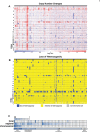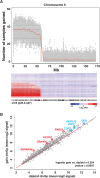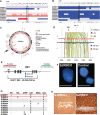RB1 gene inactivation by chromothripsis in human retinoblastoma
- PMID: 24509483
- PMCID: PMC3964219
- DOI: 10.18632/oncotarget.1686
RB1 gene inactivation by chromothripsis in human retinoblastoma
Abstract
Retinoblastoma is a rare childhood cancer of the developing retina. Most retinoblastomas initiate with biallelic inactivation of the RB1 gene through diverse mechanisms including point mutations, nucleotide insertions, deletions, loss of heterozygosity and promoter hypermethylation. Recently, a novel mechanism of retinoblastoma initiation was proposed. Gallie and colleagues discovered that a small proportion of retinoblastomas lack RB1 mutations and had MYCN amplification [1]. In this study, we identified recurrent chromosomal, regional and focal genomic lesions in 94 primary retinoblastomas with their matched normal DNA using SNP 6.0 chips. We also analyzed the RB1 gene mutations and compared the mechanism of RB1 inactivation to the recurrent copy number variations in the retinoblastoma genome. In addition to the previously described focal amplification of MYCN and deletions in RB1 and BCOR, we also identified recurrent focal amplification of OTX2, a transcription factor required for retinal photoreceptor development. We identified 10 retinoblastomas in our cohort that lacked RB1 point mutations or indels. We performed whole genome sequencing on those 10 tumors and their corresponding germline DNA. In one of the tumors, the RB1 gene was unaltered, the MYCN gene was amplified and RB1 protein was expressed in the nuclei of the tumor cells. In addition, several tumors had complex patterns of structural variations and we identified 3 tumors with chromothripsis at the RB1 locus. This is the first report of chromothripsis as a mechanism for RB1 gene inactivation in cancer.
Figures





References
-
- Rushlow DE, Mol BM, Kennett JY, Yee S, Pajovic S, Theriault BL, Prigoda-Lee NL, Spencer C, Dimaras H, Corson TW, Pang R, Massey C, Godbout R, et al. Characterisation of retinoblastomas without RB1 mutations: genomic, gene expression, and clinical studies. The lancet oncology. 2013;14(4):327–334. - PubMed
-
- Friend SH, Bernards R, Rogelj S, Weinberg RA, Rapaport JM, Albert DM, Dryja TP. A human DNA segment with properties of the gene that predisposes to retinoblastoma and osteosarcoma. Nature. 1986;323(6089):643–646. - PubMed
-
- Corson TW, Gallie BL. One hit, two hits, three hits, more? Genomic changes in the development of retinoblastoma. Genes, chromosomes & cancer. 2007;46(7):617–634. - PubMed
-
- Orlic M, Spencer CE, Wang L, Gallie BL. Expression analysis of 6p22 genomic gain in retinoblastoma. Genes, chromosomes & cancer. 2006;45(1):72–82. - PubMed
Publication types
MeSH terms
Substances
Grants and funding
LinkOut - more resources
Full Text Sources
Other Literature Sources
Miscellaneous

